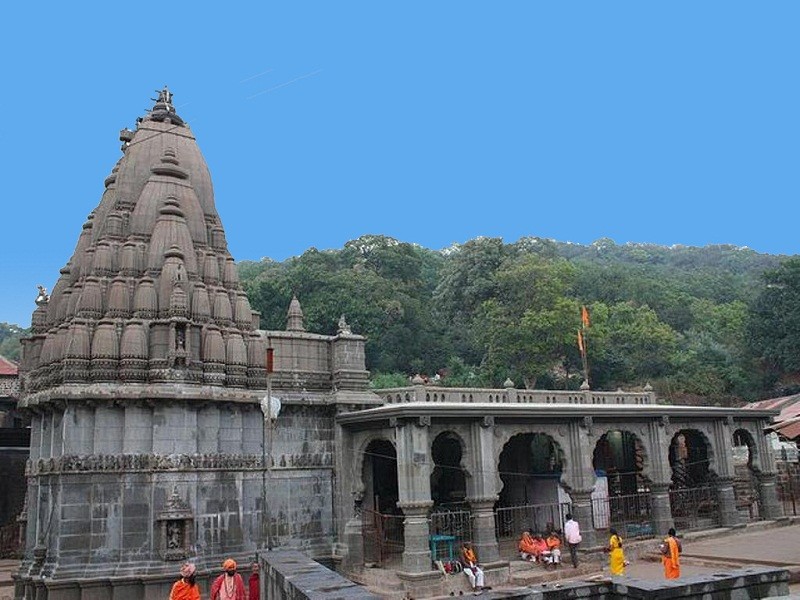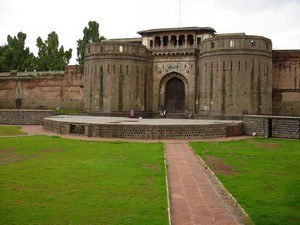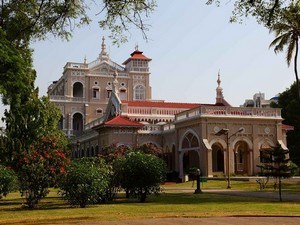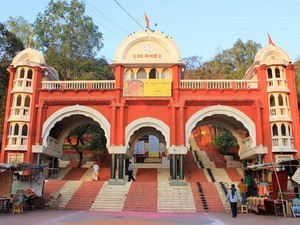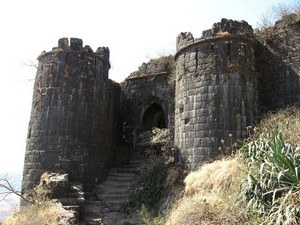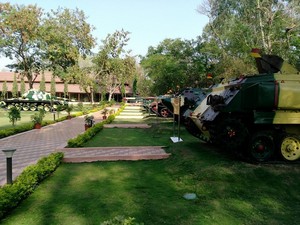Bhimashankar Temple, Pune - Timings, Festivals, History, Darshan, Pooja Timings
Photo Credit: Flickr
 India | Maharashtra | Pune
India | Maharashtra | Pune
 #7 of 66 Places to Visit in Pune
#7 of 66 Places to Visit in Pune
 Distance (From Pune Railway Station): 111 Kms
Distance (From Pune Railway Station): 111 Kms
 Trip Duration (Including Travel): 4-6 Hours
Trip Duration (Including Travel): 4-6 Hours
 Place Location: At Bhimashankar
Place Location: At Bhimashankar
 Transportation Options: Bus / Cab
Transportation Options: Bus / Cab
 Travel Tips: None
Travel Tips: None
About Bhimshankar Temple
At a distance of 111 Km from Pune, 124 Km from Lonavala, 210 Km from Nashik, and 224 Km from Mumbai, Bhimashankar Temple is an ancient pilgrimage center located near Karjat in the Ghat region of Sahyadri hills in Maharashtra. This is one of the top pilgrimage sites in Maharashtra, and also one of the best places to visit near Pune. Dedicated to Lord Shiva, it is considered one of the 12 holy Jyotirlinga shrines in India, and one among the five Jyotirlinga temples in Maharashtra.. The other Jyotirlinga shrines in Maharashtra are Vaidyanath near Parli, Trimbakeshwara near Nashik, Grishneshwar near Aurangabad, and Aundha Nagnath Temple in Hingoli. Bhimashankar is also the source of the river Bhima, which flows southeast and merges with the Krishna River near Raichur.
History of Bhimshankar Temple
The origins of the temple's construction remain unclear, yet scholars and historical texts suggest that it was established in the early 13th century. In 1437 AD, a trader from Pune named Chimaji Antanji Nayik Bhinde added a court hall to the temple. Subsequent renovations occurred during the 18th century under Maratha rule. Notably, Nana Phadnavis, a prominent figure during the Peshwa period, is credited with the construction of the Sabhamandap and the Shikhara. Additionally, the esteemed Maratha king Chhatrapati Shivaji contributed to the Bhimshankar temple to support its daily rituals and ceremonies.
Raghunathrao Peshwa also constructed a well within the temple complex. Furthermore, Chimaji Appa, the brother of Bajirao I, donated a large bell that can be seen at the temple's entrance. This bell is one of several taken from a Portuguese church, which Chimaji and his forces captured as trophies after their victory over the Portuguese at the Battle of Bacaim in 1739. The Maharashtra state government has designated the temple area as the Bhimshankar Wildlife Sanctuary under the Wildlife Protection Act of 1972. Currently, the Bhimshankar temple is managed by the Pune Municipal Corporation and the Maharashtra Government.
Mythology of Bhimshankar Temple
There are many stories associated with the Bhimshankar Temple that find mention in Hindu mythological literature. One such narrative recounts that during the Treta Yuga, Kumbhkaran, the sibling of the asura king Ravana, had a son named Bhima. Driven by a desire for vengeance against Lord Rama for his father's demise, Bhima engaged in intense penance, worshipping Lord Brahma, the creator deity, and ultimately received a boon granting him immense power. However, this newfound strength led to Bhima's arrogance, prompting him to threaten King Kamarupehsvar, demanding that he cease his worship of Lord Shiva. When the king refused, Bhima imprisoned him, yet the king continued his devotion, even crafting a Shivlinga within his cell. Overcome by his own might, Bhima attempted to destroy the Shivlinga with his sword, but Lord Shiva intervened, vanquishing him. Following this event, the deities gathered and implored Shiva to remain at the site as a Jyotirlinga, which became known as Bhimshankar Jyotirlinga. Additionally, the perspiration shed by Lord Shiva during the confrontation transformed into the Bhima River.
Another tale tells of a demon named Tripurasura, who began tormenting innocent individuals after receiving a boon of immortality from Shiva. To eliminate this threat, Shiva enlisted the help of his wife, Paravati, and together, in the form of Ardhanarishvara, they defeated the demon, restoring harmony to the land. This shrine was established in commemoration of that event.
Architecture of Bhimshankar Temple
Situated at an altitude of 1,034 feet, Bhimshankar Temple showcases a blend of Indo-Aryan and Nagara architectural styles. The temple boasts expansive courtyards, detailed wall carvings, and towering pillars. Within the sanctum, which is constructed at a lower level, lies the revered Jyotirlinga. The Swayambhu, or self-manifested Shiv Linga, is positioned centrally on the floor of the sanctum sanctorum. The temple's grand pillars and doorframes are adorned with intricate mythological carvings depicting divine figures and sacred symbols, along with notable scenes from Hindu mythology.
At the entrance of the temple stands a statue of Nandi, the sacred bull and vehicle of Lord Shiva. The temple complex also includes a smaller shrine dedicated to Lord Shani. Surrounding the temple are several Kunds (ponds), including Mokshakunda Teertha, Saravateerth, Kusharanya Teertha, and Jyanakunda. Additionally, there is a shrine named Kamalaja located near Bhimashankar Temple. Other attractions in the area include Gupt Bhimashankar, Sakshi Vinayak, Hanuman Lake, Nagphani, and Bombay Point.
In addition to its significance as a pilgrimage site, Bhimashankar is recognized as a biodiversity hotspot. The forest surrounding the temple has been designated as a wildlife sanctuary, where one can observe leopards, barking deer, sambar, and hyenas. Bhimashankar is also a favored destination for adventure seekers, with the mountains in the region being popular for trekking, hiking, and rock climbing.
Festivals of Bhimshankar Temple
Maha Shivaratri is regarded as the most significant festival held at Bhimshankar Temple annually in February or March. During this time, devotees engage in all-night vigils, recite prayers, and carry out sacred rituals to pay tribute to Lord Shiva. Additionally, the month of Shravan, typically occurring in July or August, is deemed particularly auspicious for Lord Shiva, attracting large crowds of devotees who visit the temple to offer milk and perform abhishek on the Shiva Linga. Other notable festivals celebrated at Bhimshankar include Kartik Purnima, Ganesh Chaturthi, Diwali, and Holi.
Bhimshankar Temple Dress Code & Other Restrictions
While Bhimshankar Temple doesn't have a strict dress code, it is recommended to adhere to modest clothing that covers your upper arms and legs as a sign of respect. Men are encouraged to wear a dhoti or pajama paired with an upper garment, as well as formal trousers and shirts. Women may opt for a saree, half saree, or chudidhars. It is advisable to refrain from wearing contemporary attire such as mini-skirts, shorts, and sleeveless tops while on the temple grounds.
Non-Hindus are welcome to explore the temple complex and appreciate its architectural beauty; however, access to the sanctum sanctorum may be restricted.
Bhimshankar Temple Timings
Monday: 5 AM - 3 PM & 4 PM - 9:30 PM
Tuesday: 5 AM - 3 PM & 4 PM - 9:30 PM
Wednesday: 5 AM - 3 PM & 4 PM - 9:30 PM
Thursday: 5 AM - 3 PM & 4 PM - 9:30 PM
Friday: 5 AM - 3 PM & 4 PM - 9:30 PM
Saturday: 5 AM - 3 PM & 4 PM - 9:30 PM
Sunday: 5 AM - 3 PM & 4 PM - 9:30 PM
Bhimshankar Temple Entry Fee
General Entry is Free
Special Darshan available for Rs. 500
Best Time to Visit Bhimshankar Temple
The ideal time to explore Bhimashankar is between September and February. This period is particularly favorable for visiting the Bhimashankar Temple, as it aligns with the Maha Shivaratri festival, allowing visitors to immerse themselves in the spiritual atmosphere. For adventure enthusiasts, the monsoon season offers a thrilling experience due to its challenging conditions and cooler temperatures. However, it is advisable to steer clear of Bhimashankar during the summer months, as the heat can be quite severe.
How to Reach Bhimshankar Temple
Pune boasts excellent connectivity through air, rail, and road transport. Pune International Airport is the nearest airport which is about 118 Km from Bhimshankar and is well connected by flights with major international destinations like Dubai, Thailand, Malaysia, Singapore, USA, Europe, Sri Lanka and domestic destinations including Mumbai, Hyderabad, Bangalore, Chennai, Delhi, Jaipur, Kochi, Trivandrum, Kolkata & Goa. Additionally, Pune Junction Railway Station, situated about 111 kilometers from Bhimshankar, provides train services to all major cities across India, including Mumbai, Delhi, Kolkata, Chennai, Hyderabad, and Bangalore. Travelers can reach Bhimshankar Jyotirlinga from Pune by taking a bus or hiring a cab. Furthermore, Bhimshankar is also accessible by bus from Thane and Mumbai.



